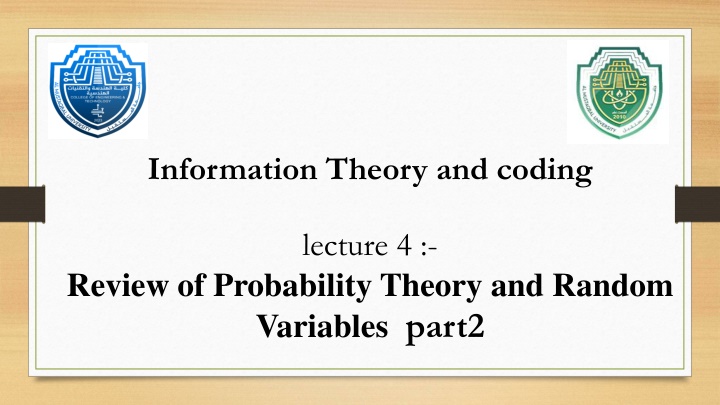
Coding Lecture 4: Review of Probability Theory and Random Variables
In this lecture, you will review probability theory, random variables, binary symmetric channels, types of random variables (discrete and continuous), and probability density functions. Understand the concepts with examples and learn about noisy channels. Explore the probabilities associated with different transitions and variables. Dive into the realm of information theory and coding.
Download Presentation

Please find below an Image/Link to download the presentation.
The content on the website is provided AS IS for your information and personal use only. It may not be sold, licensed, or shared on other websites without obtaining consent from the author. If you encounter any issues during the download, it is possible that the publisher has removed the file from their server.
You are allowed to download the files provided on this website for personal or commercial use, subject to the condition that they are used lawfully. All files are the property of their respective owners.
The content on the website is provided AS IS for your information and personal use only. It may not be sold, licensed, or shared on other websites without obtaining consent from the author.
E N D
Presentation Transcript
Information Theory and coding lecture 4 :- Review of Probability Theory and Random Variables part2
Binary Symmetric Channel Noiseless Channel: P(0R ) = P(0T) and P(1R ) = P(1T) P(0R | 1T ) = P(1R | 0T ) = 0 (no transition error ) Also P(0R | 0T ) = P(1R | 1T ) = 1 (totally correct transition) Note:-in practice the channel is not noiseless (i.e. noisy).
Binary Symmetric Channel Noisy Channel: P(0R ) P(0T) and P(1R ) P(1T) P(0R | 1T ) = P(1R | 0T ) 0 (there is transition error ) Also P(0R | 0T ) = P(1R | 1T ) 1 (partially correct transition)
Example Given: P(0T) =0.6 , P(1T ) = 0.4 and P(0R | 1T ) = P(1R | 0T ) = 0.1 Find: P(0R | 0T ) , P(1R | 1T ) , all p(T R) , P(0R) and P(1R )
Types of Random Variables A. Discrete Random Variables (DRV) limited number of values for the variables. We call this number as N. Each value of DRV has probability value ?? usually determined by probability rules. The probability of DRV may be defined by the relative frequency ?? = ?? /? .
Example In die experiment the output number is DRV. The number of variables is limited to 6, thus it is discrete random variable.
Types of Random Variables Continues Random Variables (CRV) In CRV, the random variable has unlimited values (N ). Thus ?? is undefined this case. Example: Noise waveform
Probability Density Function (pdf) of CRV Probability Density Function (or pdf f(x)) is defined and used for CRV to determine probability of given range of the CRV x as given below: ??(?)?? p( a < x < b ) = ? Properties of pdf f(x) a) f(x) is non-negative function (may be zero or +ve) b) f(x) < 1 c) ?(?)?? = 1 and p(x=a) =0 (why)






















